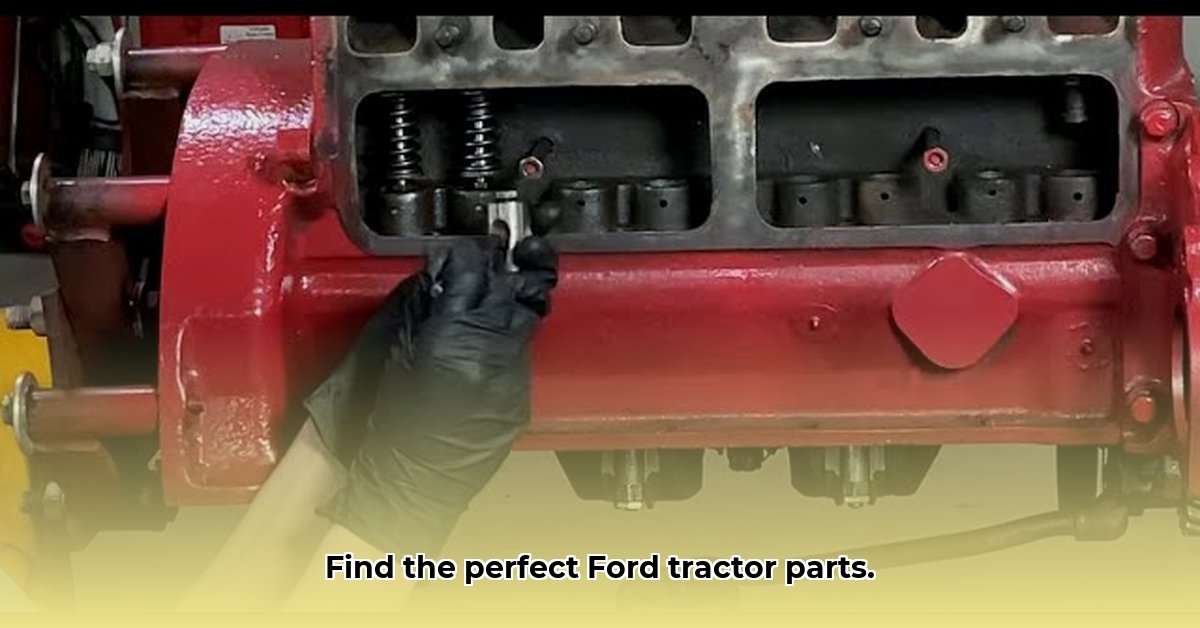
Understanding Ford Tractor Engine Types
Ford produced a wide range of tractor engines, categorized primarily by displacement (cubic inches or liters) and fuel type (gasoline or diesel). Knowing your engine's specifics is crucial for ordering the correct parts. Common displacements include 134, 175, 200, and 411 cubic inches, and 6 and 7.8-liter diesel options. This information, usually found on a data plate on the tractor or in the owner's manual, is essential for accurate part identification. Have you checked your tractor's data plate yet? This simple step can save you significant time and frustration. For more specialized parts, check out this helpful resource: Ford 8N parts.
Identifying Parts and Components
Your Ford tractor engine comprises numerous interconnected parts. Understanding their function helps with maintenance and repairs. Key components include:
- Engine Block: The foundation, housing moving parts.
- Cylinder Head: Houses valves and combustion chambers.
- Crankshaft: Converts piston motion into rotational power.
- Connecting Rods: Link pistons to the crankshaft.
- Pistons: Create power strokes within cylinders.
- Valves: Control fuel and air flow.
Regularly inspecting these components for wear and tear prevents costly major repairs. Did you know that proactive maintenance can extend your engine's lifespan by up to 25%? Prioritizing regular checks significantly improves your tractor's operational longevity.
Finding and Sourcing Parts
Several reliable sources exist for Ford tractor parts:
Online Marketplaces: Websites specializing in agricultural equipment offer price comparisons, but always check reviews. A 90% positive rating is a good benchmark for online suppliers.
Local Dealerships: Dealers stock a wide range of parts and offer expert advice, particularly for less common components.
Used Parts Dealers: Used or rebuilt parts offer cost savings but require careful inspection. Always assess the condition of used parts before installation; a thorough check can save you from future headaches.
Specialized Online Retailers: Some retailers focus solely on Ford tractor parts, often offering competitive pricing and extensive catalogs.
Choosing the Right Supplier: Consider reputation, pricing, availability, and warranty when selecting a supplier. A reliable supplier is an essential investment in your tractor's longevity.
Repair and Maintenance
Routine maintenance keeps your Ford tractor running smoothly. This includes:
Oil Changes: Adhere to the recommended intervals in your owner's manual. Using the correct oil type is crucial for optimal engine performance and longevity.
Filter Replacements: Regular replacement of fuel, air, and oil filters ensures clean operation and extends engine life.
Coolant Checks: Regularly check coolant levels to prevent overheating.
Belt Inspections: Visually inspect belts for wear and tear; replace frayed or cracked belts promptly.
Rebuilding Engines (Optional)
Rebuilding a damaged engine can be cost-effective compared to replacement, especially for older models. However, this requires mechanical expertise and specialized tools. Weigh the costs and your mechanical skills carefully before undertaking engine rebuilding.
Troubleshooting Common Ford Tractor Motor Issues
Even with regular maintenance, problems can arise. Some common issues and their solutions are:
| Problem | Possible Causes | Potential Solutions |
|---|---|---|
| Low Engine Power | Clogged fuel filter, worn fuel injectors, low compression | Check and clean/replace fuel filter, injectors; compression test. |
| Engine Overheating | Low coolant level, faulty thermostat, clogged radiator | Top up coolant; replace thermostat; flush radiator. |
| Difficult Starting | Weak battery, faulty starter motor, fuel delivery issues | Charge/replace battery; check starter motor; check fuel system. |
| Excessive Smoke (Blue/White) | Worn piston rings, leaking valve seals, worn cylinder walls | Engine overhaul might be necessary. |
| Excessive Smoke (Black) | Over-fueling, restricted air intake | Check fuel delivery system and air filter. |
This guide helps navigate the complexities of Ford tractor motor parts. Remember, proactive maintenance and careful part selection are key to ensuring your tractor's longevity and performance.